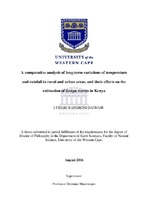| dc.description.abstract | My Thesis aimed at expanding the current knowledge on how variations of temperature
characteristics including the possible existence of urban heat islands (UHI) over urban areas
of Kenya could be influencing rainfall characteristics, and to examine if the stationary
extreme value distributionis still suitable for modeling urban storm designs in view of the
global climate change. My hypothesis was that the floodingoccurring frequently in major
urban areas of Kenya are due to increased rainfall caused by global climate change, and the
urban heat island (UHI) effect. To put this perception into perspective, temperature and
rainfall characteristics and their inter-relationships, of four of the major urban areas in Kenya
namely, Nairobi, Mombasa, Kisumu, and Nakuru, were investigated. I obtained data from
meteorological stations in and around each urban area, which had at least thirty (30) years of
continuous monthly (or daily) temperatures and rainfall values, from the Kenya
Meteorological Department. I checked the datasets for quality and missing values and
adjusted where necessary before commencing with analysis. I sourced other supporting
global dataset from various websites' data banks.I used various methods of data analysis
which included; i) exploratory data analysis techniques such as the continuous wavelet
transform (CWT), geographical information system (GIS) maps, and visual time series plots.
In particular and unique in my Thesis was the use of the CWT method as a diagnostic tool to
examine non-stationaritiesand variability of temperature and rainfall time series. | |

